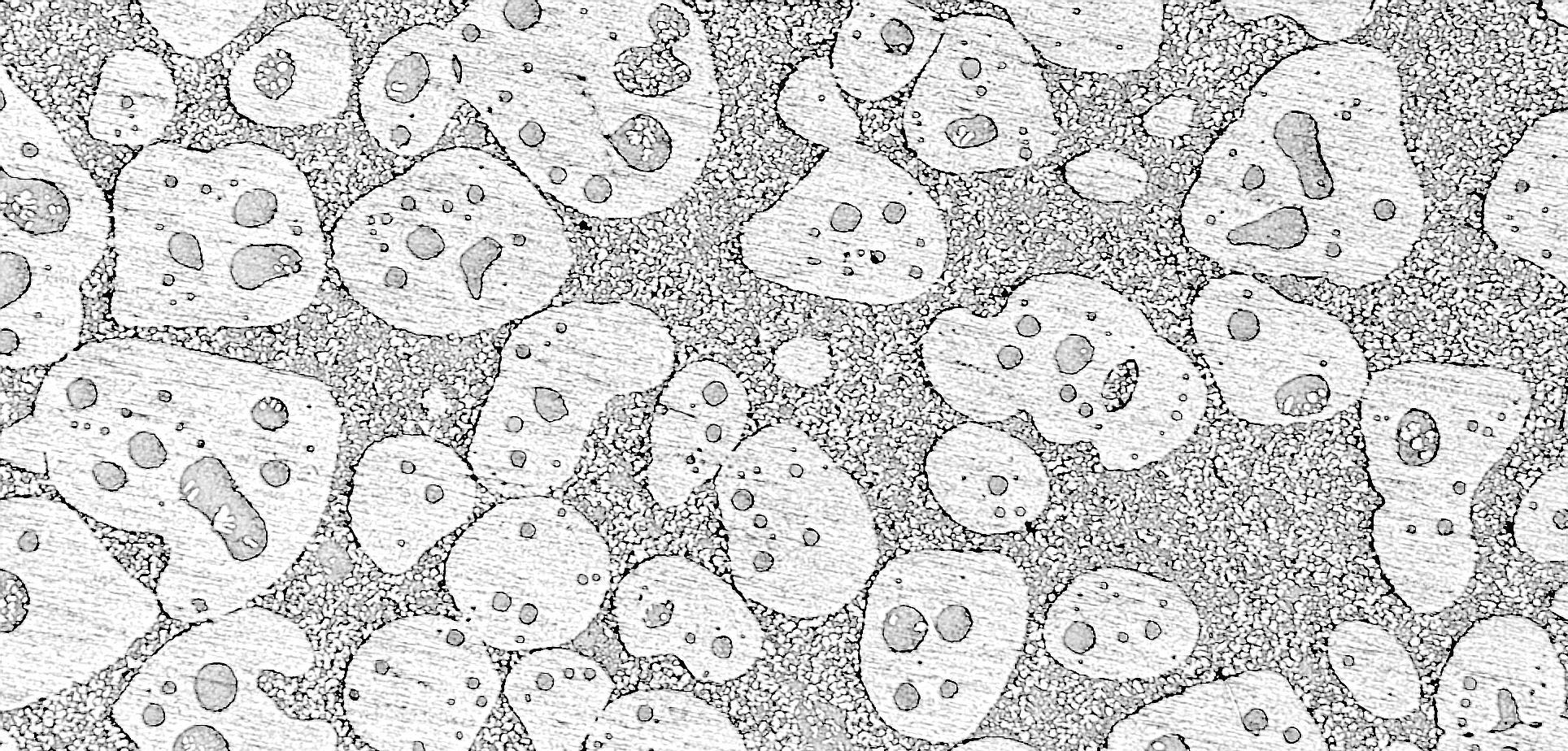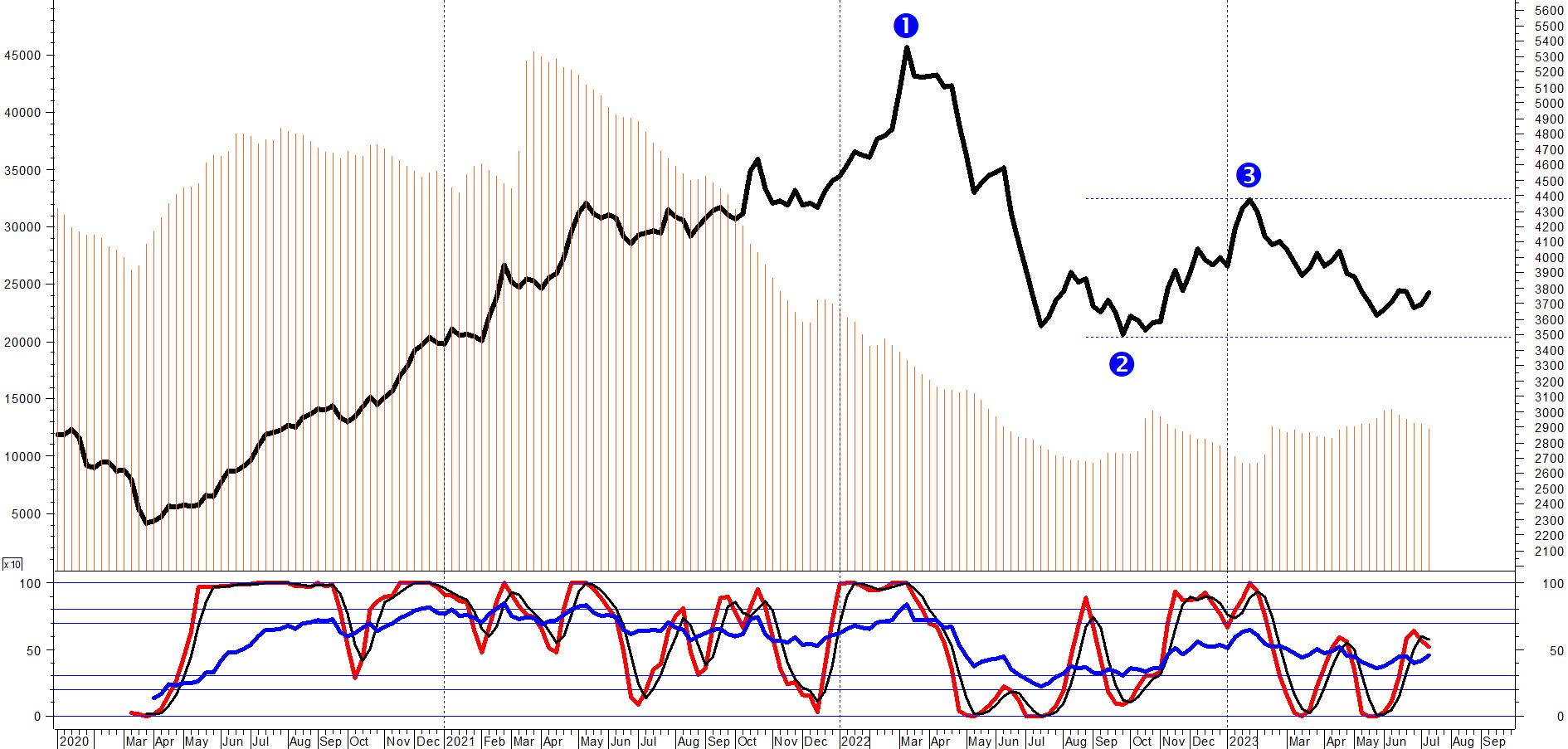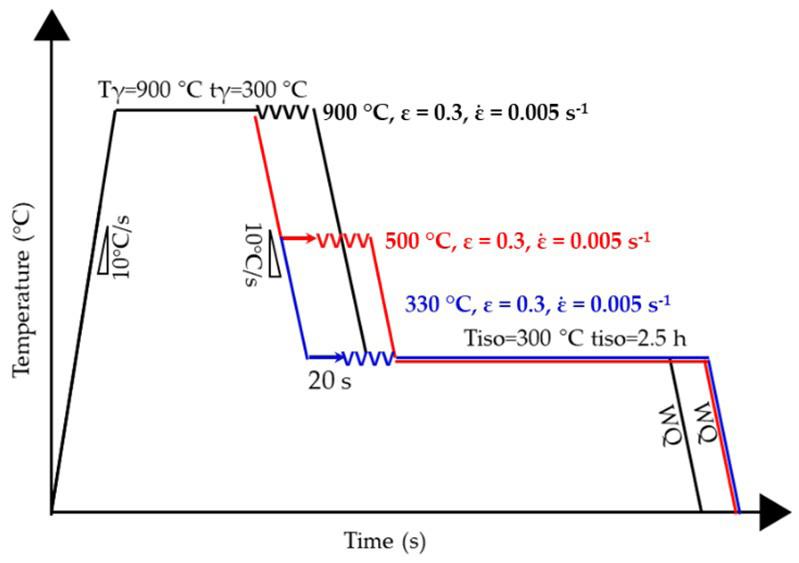
4 minute read
Scientific papers - Heat Treatment
must considered to limitate the block size and volume fraction in order to delay TRIP effect at high strain level. Nowadays, considering the actual environmental problems and the requirement of energy saving, coupled with the possibility of tailoring the properties of bainite through thermomechanical treatment, Ausforming is receiving great attention. Ausforming is a thermomechanical treatment that involves the plastic deformation of undercooled austenite, followed by a bainitic and/or martensitic transformation. Depending on the temperature at which austenite is deformed, it is possible to differentiate three ausforming regimes: i) High-temperature ausforming (HTA) close to the non-recrystallization temperature; ii) medium temperature ausforming (MTA) when the deformation is applied at temperatures between the ferrite/ pearlite and the bainite bays in the TTT diagram; iii) Lowtemperature ausforming (LTA), when the deformation is applied close to the transformation temperature. Among the advantages deriving the application of plastic deformation of the undercooled austenite, the most relevant are: the acceleration of the bainite reaction and the microstructural refinement. In addition, due to the displacive nature of the bainitic transformation ausforming is responsible for non-negligible microstructural changes that could affect the mechanical response of the material, such as the mechanical stabilization of austenite, stressstrain induced transformation during the deformation stage, variant selection phenomena (5).
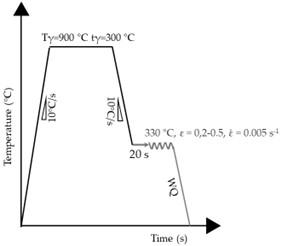
Experimental
Material and thermomechanical treatment-set up
The steel used in this work is a medium-carbon (0.38 wt.%), high-silicon (3.2 wt.%) carbide-free bainitic steel with composition developed by the authors (6,7), in form of cylindrical specimens with a diameter of 12 mm and length of 14 mm. The tests were performed, according to the scheme in Figure 1, with a Gleeble 3800 thermomechanical simulator equipped with a compressive deformation module, using silicon carbide punchers and graphite films to reduce friction. A first sample was austenitized at 900 °C for 5 minutes, (heating rate of 10 °C/s), subjected to a compressive deformation equal to 0.3 (strain rate 0.005 s-1) and subsequently cooled to 300 °C at 10 °C/s and isothermally held for 2.5 hours to ensure the completion of the bainitic transformation. The other specimens after austenitization were cooled at 10 °C/s to the deformation temperature (500 °C and 330 °C respectively) and isothermally held for 20 s to homogenize the temperature, and then subjected to deformation equal to 0.3 and strain rate 0.005 s-1. Similarly, after the deformation, the specimens were cooled to 300 °C, held for 2.5 hours and water quenched to room temperature. Finally, to investigate strain-induced transformations at low temperatures, two specimens were subjected to the same austenitization conditions, cooled at 330 °C, and after 20 s subjected to strains equal to 0.2 and 0.5. After the deformation specimens were water quenched at room temperature. The specimen’s temperature was monitored during thermomechanical processing through a K-thermocouple spot-welded on the specimen's central surface.
Microstructural investigation
Microstructural investigation was performed by means of scanning electron microscopy (LEO STEREOSCAN 440) after standard metallographic preparation, while the phase identification and quantification were carried out by X-ray diffraction (Siemens D500), equipped with a CuKα radiation tube, scanning an angular range of 2ϴ=40°105° with a speed of 0.5°/min. Rietveld analysis of the diffraction patterns was subsequently performed for the quantification of the phases present (Maud software) (8).
Results And Discussion
The true stress-true strain curves, recordered during ausforming treatments, are represented in Figure 2. The yield strength of the undercooled austenite at the various deformation temperatures was estimated by the 0.2% criterion (9), and the values are summarized in Figure 2. As expected, the values of yield strength increase with temperature decrease from 22 to 148 MPa. All the curves show a progressive increase in the true stress as the true strain increases, however, negative deflections were observed for the curves recorded at 900, and 500 °C due to recovery, and, at the highest temperature, recrystallization. Finally, these negative deflections are less pronounced as the deformation temperature decreases.
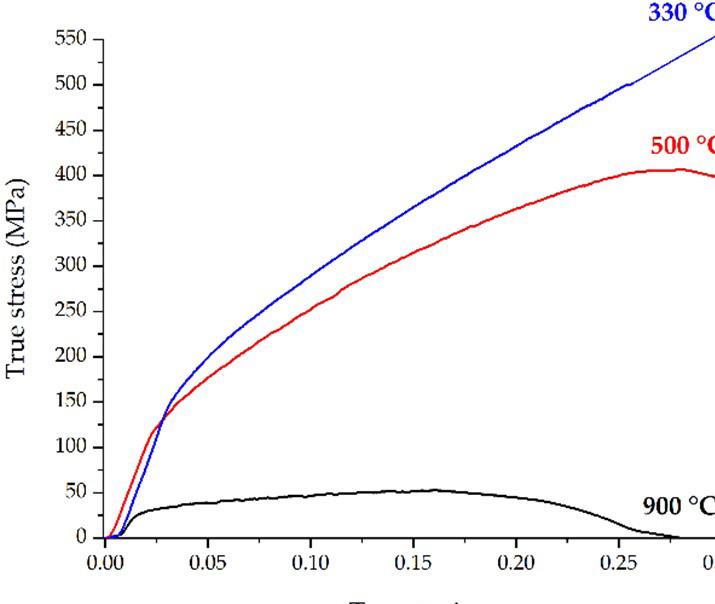
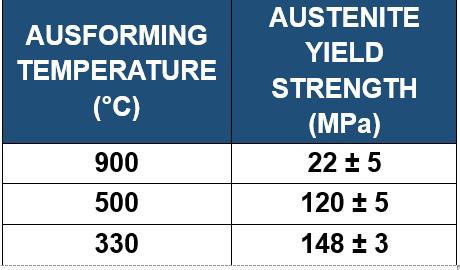
The SEM micrographs in Figure 3 display the microstructure after the pure isothermal treatments at 300 °C and after ausforming at the investigated temperatures. Compared to the pure isothermal treatment, where a microstructure consisting of bainitic ferrite and highcarbon enriched austenite, in form of blocks and films, with random orientation within the prior austenite grains. A similar microstructure can be observed after Ausforming at 900 °C since it does not introduce major modifications in the bainite morphology. Ausforming at 500 °C produces pancake-like grains and a more fragmented microstructure, with shorter sheaves and larger blocks of retained austenite. After deformation at 330 °C and isothermal holding at 300 °C the microstructure exhibits a dramatic refinement of the plates that are preferably aligned at ± 45° to the deformation direction, leading to plates crossing each other with an angle of 90° and large blocks. Furthermore, as shown by the results of the Rietveld refinement, it is evident that as the deformation temperature decreases (from 900 °C to 330°C) the volume of retained austenite increases. On one hand, ausforming increases the number of nucleation sites for bainitic ferrite, leading to an increase in the final amount of bainite, while on the other hand deformation of undercooled austenite can imply a degree of mechanical stabilization of austenite, that hinders the formation of bainitic ferrite.
Moreover, even though the fraction of bainitic ferrite decreases, which is harder compared to austenite, hardness increases, as a consequence of the refinement, and the strengthening of bainitic ferrite and austenite.
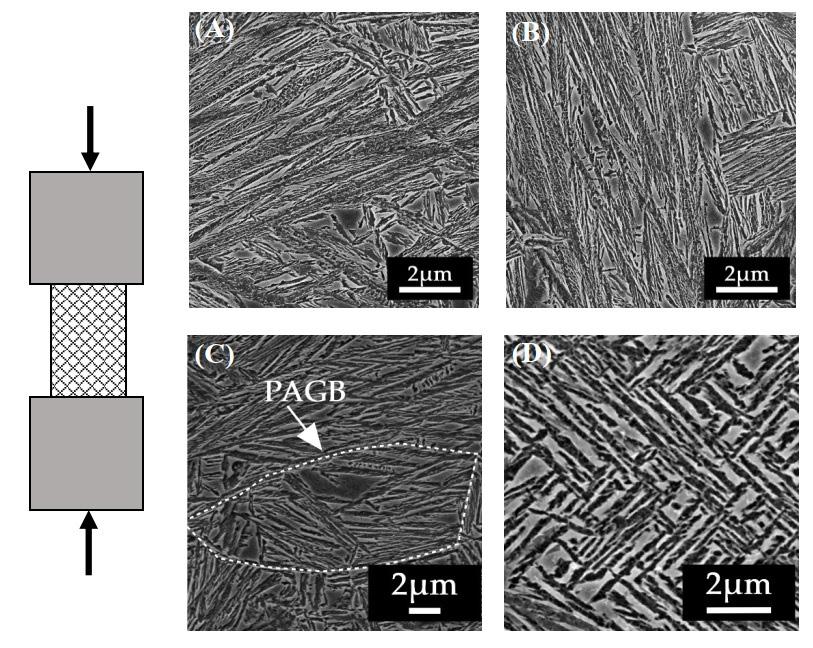
A closer look at the flow curves recorded at 300 °C led to observe that austenite continuously hardens at all the deformation levels, and, in addition, a continuous increase in dislocation density follows the application of the deformation without softening. However, the curve exhibits a linear behaviour only until a strain approximately 0.15, where inflection and a change in slope are observed. After single compression and water quenching to room temperature, the specimen microstructure consists of a martensitic matrix derived from the quenching to room temperature and bainitic plates within the grain, whose amount increases with the deformation. This inflection in the stress-strain curves along with the detection of bainitic ferrite suggests that part of the phase transformation is induced by the strain and occurs owing to the application of plastic deformations, reaching completion during the isothermal holding. The presence of strain-induced bainitic transformation suggests also that bainitic transformation is accelerated by the application of lowtemperature ausforming treatments. The hypotheses find confirmation in the thermodynamic calculations provided in Figure 5, which shows that the application of the deformation increases the driving force for the bainitic transformation.
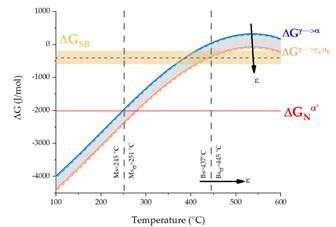
Fig.5 - Evolution of the driving force for the transformation of austenite to martensite/ bainite, showing the calculated critical onsets of both martensitic and bainitic transformation, considering only the composition, the thermal and the mechanical contribution,Msσ and Bsσ evaluation for the definition of the stress/strain-induced transformation field.




